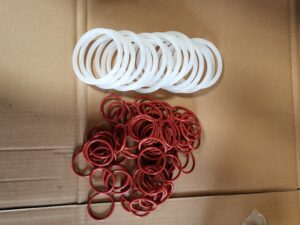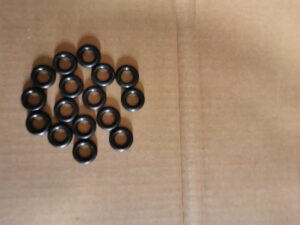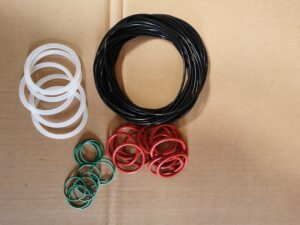Table of Contents
ToggleWhy Do We Need O-Rings?
O-rings are indispensable components in modern engineering and industrial systems, serving as critical sealing solutions across countless applications. Their unique design, material versatility, and functional efficiency make them a cornerstone of reliability in both simple and complex machinery. Below is a comprehensive exploration of why O-rings are essential, structured to highlight their core advantages and applications.



1. Leak Prevention and Pressure Maintenance
The primary purpose of an O-ring is to prevent leaks and maintain system pressure, ensuring the integrity of fluid or gas containment.
-
Sealing Mechanism:
The circular, doughnut-shaped design allows O-rings to fit into precisely machined grooves between two mating surfaces. When compressed, the O-ring deforms to fill microscopic gaps, creating an impermeable barrier against leaks. This deformation is critical in static applications (e.g., pipe joints) and dynamic systems (e.g., pistons or rotating shafts).-
Self-Energizing Effect: Under pressure, the O-ring is forced outward against the groove walls, enhancing the seal as internal pressure increases. This property makes O-rings exceptionally effective in high-pressure environments, such as hydraulic systems or pressurized gas chambers.
-
-
Pressure Handling:
In systems like hydraulic pumps or aerospace fuel lines, maintaining consistent pressure is vital for performance and safety. O-rings adapt to pressure fluctuations by expanding further into gaps, ensuring a reliable seal even under extreme conditions.
2. Versatility Across Static and Dynamic Applications
O-rings are uniquely suited to serve in diverse environments, from stationary machinery to moving components.
-
Static Sealing:
In fixed applications (e.g., pipe flanges or water bottle lids), O-rings provide long-term sealing without degradation, resisting wear from vibration or thermal cycling. -
Dynamic Sealing:
For moving parts, such as hydraulic cylinders or pump shafts, O-rings withstand friction and cyclical motion while retaining their shape. Their elastomeric flexibility accommodates minor misalignments, reducing wear on machinery. -
Industry-Specific Adaptability:
O-rings are used in automotive engines (high-temperature resistance), medical devices (biocompatible materials), and food processing (hygienic seals). This adaptability stems from tailored material choices, ensuring compatibility with specific operational demands.
3. Cost-Effectiveness and Operational Efficiency
O-rings offer economic advantages over complex sealing alternatives, making them a preferred choice for engineers.
-
Simple Design, Low Cost:
The toroidal shape requires minimal material and machining precision compared to flat gaskets or custom seals. This simplicity reduces manufacturing costs and simplifies inventory management. -
Ease of Installation and Maintenance:
O-rings do not require specialized tools or labor-intensive installation. Their compact size allows quick replacement, minimizing downtime in industrial settings. -
Space Efficiency:
The small footprint of O-rings makes them ideal for applications with limited space, such as compact valves or electronic enclosures.
4. Material Flexibility and Durability
The performance of O-rings hinges on selecting the right material for the operating environment.
-
Material Diversity:
O-rings are manufactured from elastomers (Nitrile, Viton®, Silicone), plastics (PTFE), or metals. Each material offers distinct advantages:-
Nitrile (NBR): Resistant to oils and fuels, ideal for automotive use.
-
Fluorocarbon (FKM): Withstands high temperatures and aggressive chemicals, suited for aerospace.
-
EPDM: Excellent for water and steam applications, common in plumbing.
-
-
Resilience and Longevity:
Elastomeric O-rings exhibit “rubber memory,” allowing them to return to their original shape after compression. This self-restoring property ensures longevity even in high-cycle applications. -
Failure Prevention:
Proper material selection is critical to avoid catastrophic failures, as demonstrated by the Challenger space shuttle disaster. Compatibility with temperature, chemicals, and mechanical stress must be rigorously evaluated.
5. Critical Applications Across Industries
O-rings are ubiquitous in systems where reliability is non-negotiable:
-
Hydraulics and Pneumatics: Sealing pistons, valves, and pumps.
-
Aerospace: Fuel systems, cabin pressure regulation.
-
Medical Devices: Sterile seals for surgical instruments.
-
Consumer Goods: Water bottles, appliances, and automotive components.
Conclusion
We need O-rings because they provide a simple yet robust sealing solution that balances performance, cost, and adaptability. Their ability to prevent leaks, withstand pressure, and function in diverse environments ensures the safety, efficiency, and longevity of mechanical systems. By leveraging material science and precision engineering, O-rings address challenges that alternative seals cannot, solidifying their role as an irreplaceable component in modern industry.



Leave A Comment